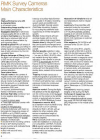The terminology is getting really confusing, to me anyway.
I take it that in standard usage a
negative image of a scene is one in which brightness values are reversed: light areas in the scene appear dark in the image, while dark areas in the scene appear light in the image. Whereas in a
positive image light areas in the scene appear light in the image, and dark areas appear dark. I hope this is uncontroversial?
Suppose that by some process (for the present purpose it doesn't matter what) a
negative image is taken of an existing
negative image. The result would be to reverse the brightness values of the existing image, so that light areas in that image would appear dark in the copy, and vice versa. But the light areas in that image represent dark areas in the original scene, so the effect of taking the
negative copy is to produce a
positive image of the original scene.
But then along comes the
interpositive image to muddy the waters. I have looked at several definitions, but there does not seem to be a standard interpretation of the term. The Wikipedia article 'Interpositive'
https://en.wikipedia.org/wiki/Interpositive
describes it as a 'negative image created by a positive process'. This apparently means a process which retains the brightness values of an original negative image, so that dark areas in the original image also appear dark in the interpositive. This implies that dark areas in the original external scene will appear light in the interpositive, and light areas in the scene will appear dark in the interpositive. In this sense an
interpositive will therefore look like a
negative.
But wait - other sources give the opposite interpretation! This dictionary of terms used in archives
https://dictionary.archivists.org/entry/interpositive.html
defines 'interpositive' as
The 'interpositive' will therefore look like a
positive image of the original scene - one with 'normal polarity' This usage also appears to be followed by the National Archives in the USA:
https://www.archives.gov/preservation/products/definitions/in.html#:~:text=An Interpositive is a positive,negatives rather than for projection.
I suppose it doesn't matter what definitions we use so long as they are clear and consistent. So far as the Lago de Cote images are concerned, there seems to be a consensus in recent posts that the images we are talking about are
positive with respect to the original scene, i.e. that dark areas in the original scene appear dark in the images and light areas appear light. Notably, it is pointed out that clouds viewed from above should look light, as they do in the images. I have no expertise in interpreting aerial photographs, so I can't judge that. It does seem odd that lots of people over the years have looked at images which are frequently described as 'negatives' without saying: hang on, aren't these positives?


